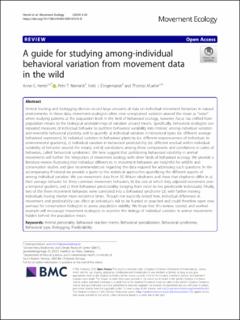| dc.contributor.author | Hertel, Anne Gabriela | |
| dc.contributor.author | Niemelä, Petri T. | |
| dc.contributor.author | Dingemanse, Niels J. | |
| dc.contributor.author | Mueller, Thomas | |
| dc.date.accessioned | 2021-03-09T09:51:44Z | |
| dc.date.available | 2021-03-09T09:51:44Z | |
| dc.date.created | 2021-02-23T14:04:54Z | |
| dc.date.issued | 2020 | |
| dc.identifier.citation | Hertel, A. G., Niemelä, P. T., Dingemanse, N. J. & Mueller, T. (2020). A guide for studying among-individual behavioral variation from movement data in the wild. Movement Ecology, 8, 30. | en_US |
| dc.identifier.issn | 2051-3933 | |
| dc.identifier.uri | https://hdl.handle.net/11250/2732319 | |
| dc.description.abstract | Animal tracking and biologging devices record large amounts of data on individual movement behaviors in natural environments. In these data, movement ecologists often view unexplained variation around the mean as "noise"when studying patterns at the population level. In the field of behavioral ecology, however, focus has shifted from population means to the biological underpinnings of variation around means. Specifically, behavioral ecologists use repeated measures of individual behavior to partition behavioral variability into intrinsic among-individual variation and reversible behavioral plasticity and to quantify: a) individual variation in behavioral types (i.e. different average behavioral expression), b) individual variation in behavioral plasticity (i.e. different responsiveness of individuals to environmental gradients), c) individual variation in behavioral predictability (i.e. different residual within-individual variability of behavior around the mean), and d) correlations among these components and correlations in suites of behaviors, called 'behavioral syndromes'. We here suggest that partitioning behavioral variability in animal movements will further the integration of movement ecology with other fields of behavioral ecology. We provide a literature review illustrating that individual differences in movement behaviors are insightful for wildlife and conservation studies and give recommendations regarding the data required for addressing such questions. In the accompanying R tutorial we provide a guide to the statistical approaches quantifying the different aspects of among-individual variation. We use movement data from 35 African elephants and show that elephants differ in a) their average behavior for three common movement behaviors, b) the rate at which they adjusted movement over a temporal gradient, and c) their behavioral predictability (ranging from more to less predictable individuals). Finally, two of the three movement behaviors were correlated into a behavioral syndrome (d), with farther moving individuals having shorter mean residence times. Though not explicitly tested here, individual differences in movement and predictability can affect an individual's risk to be hunted or poached and could therefore open new avenues for conservation biologists to assess population viability. We hope that this review, tutorial, and worked example will encourage movement ecologists to examine the biology of individual variation in animal movements hidden behind the population mean. | en_US |
| dc.language.iso | eng | en_US |
| dc.rights | Navngivelse 4.0 Internasjonal | * |
| dc.rights.uri | http://creativecommons.org/licenses/by/4.0/deed.no | * |
| dc.title | A guide for studying among-individual behavioral variation from movement data in the wild | en_US |
| dc.type | Peer reviewed | en_US |
| dc.type | Journal article | en_US |
| dc.description.version | publishedVersion | en_US |
| dc.rights.holder | © The Author(s), 2020. | en_US |
| dc.source.volume | 8 | en_US |
| dc.source.journal | Movement Ecology | en_US |
| dc.identifier.doi | https://doi.org/10.1186/s40462-020-00216-8 | |
| dc.identifier.cristin | 1892765 | |
| dc.source.articlenumber | 30 | en_US |
| cristin.ispublished | true | |
| cristin.fulltext | original | |
| cristin.qualitycode | 1 | |

